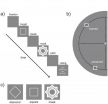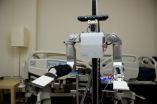(Press-News.org) Cardiff University astronomers believe that a young star's long "napping" could trigger the formation of a second generation of smaller stars and planets orbiting around it.
It has long been suspected that the build up of material onto young stars is not continuous but happens in episodic events, resulting in short outbursts of energy from these stars.
However, this has been largely ignored in models of star formation.
Now, by developing advanced computer models to simulate the behaviour of young stars, Cardiff University Astrophysicists Dr Dimitris Stamatellos and Professor Anthony Whitworth, along with Dr David Hubber from the University of Sheffield, have offered a new insight in star formation.
While stars are young they are surrounded by discs of gas and dust, and grow by accreting material from these discs. The discs may break-up to give birth to smaller stars, planets and brown dwarfs - objects larger than planets but not large enough to burn hydrogen like our Sun.
"We know that young stars spend most of their early lives sleeping," said Dr Dimitris Stamatellos. "After they have their lunch, a large chunk of dust and gas from their discs, they take a nap that lasts for a few thousand years. During this nap their brightness is very low.
"As they sleep, their discs grow in mass, but they remain relatively cool, despite the presence of stars right at their centres. Eventually, these discs become unstable and fragment to form low-mass stars and substellar objects, like brown dwarfs and planets."
To date, research has suggested that the radiation from the parent star could heat and stabilize the disc, suppressing its breaking up.
However, the researchers discovered that there is ample time in between outbursts to allow the disc to break up and give birth to a new generation of low-mass stars, brown dwarfs, and planets.
The new theory provides an explanation for the formation and the properties of stars with masses below a fifth of that of our Sun, which are estimated to constitute more than 60% of all stars in our Galaxy.
"Our findings suggest that disc fragmentation is possible in nature," says Dr Stamatellos.
"It is important now to investigate whether this is the dominant mechanism for the formation of low-mass stars and brown dwarfs," he adds.
###
The research was funded by the Science and Technology Facilities Council (STFC) and the Leverhume Trust, and published in the Astrophysical Journal.
Baby stars born to 'napping' parents
2011-03-10
ELSE PRESS RELEASES FROM THIS DATE:
Aspirin's ability to protect against colorectal cancer may depend on inflammatory pathways
2011-03-10
The reduced risk of colorectal cancer associated with taking aspirin or other nonsteroidal anti-inflammatory drugs (NSAIDs) may be confined to individuals already at risk because of elevations in a particular inflammatory factor in the blood. In a paper in the March issue of Gastroenterology, investigators from Massachusetts General Hospital (MGH) and Dana-Farber Cancer Institute report finding that higher baseline levels of a novel inflammatory marker indicated increased risk of developing colorectal tumors and also predicted who might benefit from taking aspirin or NSAIDs. ...
Which side of the brain rotates a mental picture?
2011-03-10
Milan, Italy, 9 March 2011 – Consider the simple situation in which you are walking around the kitchen and decide to pick up your own cup of tea, which is identical to others lying on the table. Your brain chooses the correct cup of tea by using different types of information that you have stored about the position of the cup in relation to the kitchen table. The information can be represented in qualitative terms (left, right, above, below) or quantitative terms (distances and angles). Previous studies have claimed that the brain's left hemisphere is critical for processing ...
How do we combine faces and voices?
2011-03-10
Milan, Italy, 9 March 2011 – Human social interactions are shaped by our ability to recognise people. Faces and voices are known to be some of the key features that enable us to identify individual people, and they are rich in information such as gender, age, and body size, that lead to a unique identity for a person. A large body of neuropsychological and neuroimaging research has already determined the various brain regions responsible for face recognition and voice recognition separately, but exactly how our brain goes about combining the two different types of information ...
Alcohol abuse history influences quality of life following liver transplant
2011-03-10
A history of alcohol abuse significantly impacts quality of life for patients after liver transplant, according to researchers at Henry Ford Hospital.
"Transplant recipients with alcoholic cirrhosis experienced less improvement in physical quality of life and reported greater pain and physical limitations than non-alcoholics after transplant surgery," says Anne Eshelman, Ph.D., Henry Ford Behavioral Health Services, lead author of the study.
"Understanding alcoholic and nonalcoholic patients' post-transplant change in quality of life may assist in treatment planning. ...
EU tariffs obstacle to trade with the rest of the world
2011-03-10
Increased imports often mean cheaper products for EU consumers and greater opportunities for producers in other countries to export their products, but also increased competition for EU producers.
"I have compared various product groups and found that the effects of a reduction in tariffs would be different for fruit and vegetables and for cereals", says Cecilia Hammarlund, who is behind the report Handel med hinder – effekter av tullar på EU:s jordbruksimport (Trade with obstacles – effects of tariffs on EU agricultural imports).
The study shows that an average reduction ...
Redefining normal blood pressure
2011-03-10
As many as 100 million Americans may currently be misclassified as having abnormal blood pressure, according to Dr. Brent Taylor from the Veterans Affairs Health Care System in Minneapolis and the University of Minnesota and his colleagues. Their findings1 show that these people are not actually more likely to die prematurely than those with 'normal' blood pressure, i.e. below 120/80. Taylor and colleagues' article in the Journal of General Internal Medicine², published by Springer, also shows that in those under 50, diastolic blood pressure* is the more important predictor ...
Learning to see consciously
2011-03-10
Our brains process many more stimuli than we become aware of. Often images enter our brain without being noticed: visual information is being processed, but does not reach consciousness, that is, we do not have an impression of it. Then, what is the difference between conscious and unconscious perception, and can both forms of perception be changed through practice? These questions are important not only for basic research, but also for the treatment of patients with perceptual deficits due to brain lesions e.g. following a stroke. Scientists at the MPI for Brain Research ...
How do people respond to being touched by a robot?
2011-03-10
For people, being touched can initiate many different reactions from comfort to discomfort, from intimacy to aggression. But how might people react if they were touched by a robot? Would they recoil, or would they take it in stride? In an initial study, researchers at the Georgia Institute of Technology found people generally had a positive response toward being touched by a robotic nurse, but that their perception of the robot's intent made a significant difference. The research is being presented today at the Human-Robot Interaction conference in Lausanne, Switzerland.
"What ...
Toward real time observation of electron dynamics in atoms and molecules
2011-03-10
Quebec City, March 9, 2011 – Another step has been taken in matter imaging. By using very short flashes of light produced by a technology developed at the national infrastructure Advanced Laser Light Source (ALLS) located at INRS University, researchers have obtained groundbreaking information on the electronic structure of atoms and molecules by observing for the first time ever electronic correlations using the method of high harmonic generation (HHG). Made by a team of researchers from the Energy, Materials, and Telecommunications Center of INRS and the National Research ...
Combating cucurbit yellow stunting disorder virus
2011-03-10
This release is available in Spanish.
U.S. Department of Agriculture (USDA) scientists are working to give melon growers some relief from cucurbit yellow stunting disorder virus, or CYSDV.
In 2006, Agricultural Research Service (ARS) plant pathologist Bill Wintermantel with the U.S. Agricultural Research Station in Salinas, Calif., and university colleagues identified the plant disease that growers in California's Imperial Valley and nearby Yuma, Ariz., noticed was spreading through their cucurbit fields. Cucurbit crops affected included cantaloupe and honeydew melons.
ARS ...

